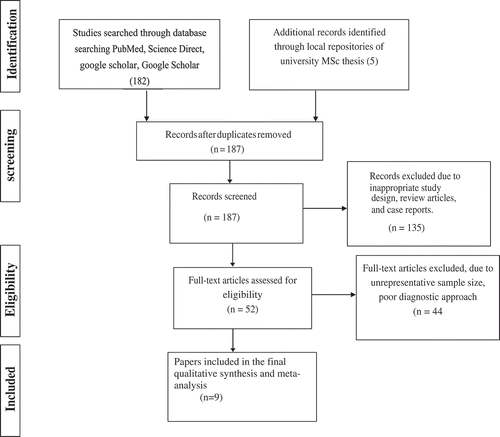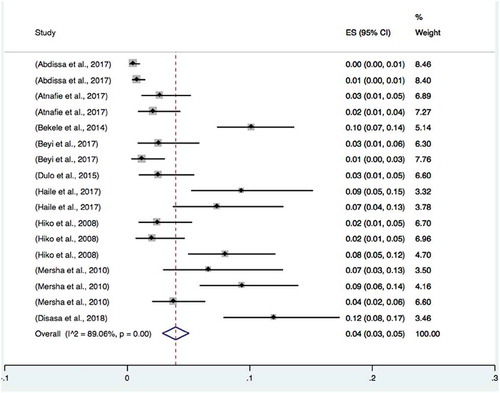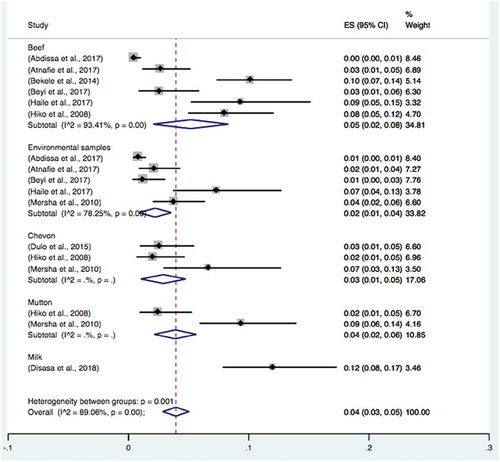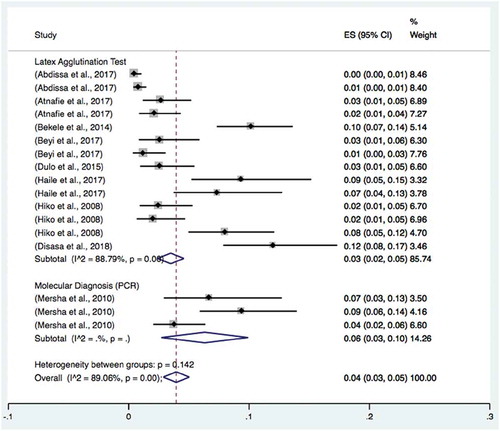Abstract
Escherichia coli O157 is one of the causes of gastrointestinal diseases in developed countries causing millions of illness annually. The occurrence of Escherichia coli in foods of animal origin in Ethiopia is arguably high due to many reasons like illegal slaughtering of animals in open fields, unhygienic slaughter practices in the abattoirs, and the risk of disease due to this organism is high because of a widespread tradition of raw meat consumption. The objective of this systematic review and meta-analysis was to pool estimates of the prevalence of the organism in different foods of animal origin which is the first of its kind in the country. The literature search was conducted to identify all published articles reporting the prevalence of Escherichia coli in foods of animal origin. From all screened articles, nine studies were eligible for final systematic review and meta-analysis. Because substantial heterogeneity was expected, random-effects meta-analyses were carried out to pool the prevalence of the organism from different foods of animal origin. Prevalence of the organism was found to be 4% (95% CI = 3%—5%) in foods of animal origin. This systematic review and meta-analysis showed the level of contamination of foods of animal origin in Ethiopia is high indicating the need for immediate planning of mitigation strategies and detection methods to reduce its level and impact throughout the country.
PUBLIC INTEREST STATEMENT
E. coli O157:H7 is one of the fearsome and highly infectious foodborne pathogens infecting a wide range of hosts. People usually become infected when they eat or drink any product contaminated with bacteria. Among foods that can be contaminated with the bacteria, foods of animal origin are the primary source of infection to humans. In order to prevent and control the spread of the infection due to this organism, studies that give the national prevalence like this are highly recommended. This systematic review and meta-analysis of prevalence of E. coli O157:H7 in Ethiopia provides an insight into the status of the diseases from foods of animal origin at the national level.
Competing Interests
The author declares no competing interests.
1. Introduction
Foodborne pathogens are the leading causes of foodborne human illness and death in the world (Agüeria, Terni, Baldovino, & Civit, Citation2018). The reason for the increased risk can be due to many reasons; changes in eating habits, mass catering, complex and lengthy food supply procedures with increased international movement and poor hygiene practices are few of them (Bevilacqua, Corbo, & Sinigaglia, Citation2017; Lopez-Campos, Martinez-Suarez, Aguado-Urda, & Alonso, Citation2012). Escherichia coli O157 is one of the virulent strain under the species Escherichia coli. It is the leading cause of hemorrhagic colitis, hemolytic-uremic syndrome (HUS) and thrombotic thrombocytopenic purpura (TTP) in man. These illnesses may lead to death due to improper absorption of nutrients and destruction of certain tissues in the target organs (Cobbaut, Houf, Buvens, Habib, & De, Citation2009; Earley & Leonard, Citation2006).
Epidemiology of foodborne pathogens especially that of Escherichia coli O157: H7 was not well studied in Ethiopia in the past years. However, recently there is an increasing trend of reporting occurrence level of the organism in beef and dairy products (Abebe et al., Citation2014; Desta, Donata, Gabriella, & Martino, Citation2016; Haileselassie, Taddele, Adhana, & Kalayou, Citation2013; Hiko, Asrat, & Zewde, Citation2008; Tassew, Abdissa, Beyene, & Gebre-Selassie, Citation2010; Taye, Citation2013). This may be because beef and dairy products are considered the risk for E. coli due to close contact with cattle manure. However, studies showed that the organism had been isolated from mutton, chicken, fish, and vegetables.
Escherichia coli O157: H7 is a well-known Shiga toxin-producing bacterium that belongs to the family Enterobacteriaceae. They are reasonably tolerant to different extreme conditions like; minimum pH for growth, heating, irradiation, antimicrobials, ruminant gastrointestinal tract fluids, and even cool nutrient-dilute water as well (Karmali, Gannon, & Sargeant, Citation2010; Yoon et al., Citation2004). The organism has gained recognition as an essential food-borne pathogen in recent years. Most strains of E. coli isolated from natural sources are harmless commensals, but the O157: H7 serotype had a highly virulent character and regarded as the ugliest Escherichia coli strain by WHO (Ayscue, Lanzas, Ivanek, & Gro, Citation2009; Berry & Wells, Citation2010). Nomenclature of Escherichia coli O157: H7 has been variously described as verotoxigenic E. coli (VTEC), Shiga like toxin-producing E. coli (SLTEC), and currently, Shiga toxin-producing E. coli (STEC) (Saeedi et al., Citation2017). Unlike any other non-pathogenic strains of E. coli, E. coli O157 has no ability to ferment sorbitol, unable to produce β- glucuronidase, has an attaching and effacing gene (eae) and, produces Shiga toxins (Stxs) that inhibit host protein synthesis (Duffy, Cummins, Nally, O’ Brien, & Butler, Citation2006; Pennington, Citation2010; Wilson et al., Citation2018).
A handful of studies have been conducted in Ethiopia that reports the occurrence level of Escherichia coli in foods of animal origin mostly in meat and milk in recent years (Atnafie et al., Citation2017; Dulo et al., Citation2015; Mengistu, Abayneh, & Shiferaw, Citation2017; Mersha, Asrat, Zewde, & Kyule, Citation2010; Taye, Citation2013). Most of the studies were conducted in central Ethiopia due to extensive animal farming practices in those areas. There are also studies throughout the country that estimate the prevalence of the organism in foods of animal origin. National level estimation and quantification of Escherichia coli occurrence can help responsible bodies for the prevention and control of its occurrence in foods before reaching end users ultimately reducing its impact. To the best of our knowledge, this review is the first of its kind in estimating the pooled prevalence of Escherichia coli in foods of animal origin in Ethiopia. The objective of the study was to pool estimates of proportions of occurrence of Escherichia coli O157:H7 in foods of animal origin to have a national estimate of the occurrence level of the organism.
2. Materials and methods
2.1. Literature search strategy
The literature search was conducted to identify all published studies reporting the prevalence of Escherichia coli O157 in foods of animal origin. It was conducted in electronic databases of PubMed, google scholar, and African Journals Online from April to May 2018. The specific search medical subject heading (MeSH) terms include “Escherichia coli and Ethiopia”, “Escherichia coli prevalence and Ethiopia”, “Escherichia coli O17: H7 and Ethiopia”, “Escherichia coli O157 and meat in Ethiopia”, “Escherichia coli O157 in milk in Ethiopia”, “Escherichia coli O157” AND “Ethiopia” AND “prevalence”. Based on the intensive literature search, a total of 187 pieces of literature that report the prevalence of Escherichia coli in Ethiopia were retrieved. However, only 30 reports on the prevalence of Escherichia coli in meat, milk, and related working environmental samples were screened, and nine of them reported the pathogenic strain E. coli O157 made it to the final meta-analysis procedure. Study screening strategy and exclusion reasons are presented in Figure .
2.2. Eligibility criteria and data extraction procedure
All Articles that report the prevalence of Escherichia coli O157 in meat and milk in Ethiopia were downloaded and added to Mendeley reference manager. Duplicates were rigorously checked and removed. Quality criteria were developed before starting the review of full papers. Inclusion/exclusion criteria were defined regarding the relevance of the articles to the research questions of interest. The inclusion criteria include an observational study that reports prevalence of the diseases, published article or MSc thesis in University online repositories, reporting the prevalence of the organism only in foods of animal origin from 2000 to 2017, diagnostic methods that employed one of the diagnostic approaches (culture, Latex agglutination, and molecular methods). Articles that met the above criteria were considered for the final meta-analysis and systematic review. Titles were checked twice in both excluded and included databases of the Mendeley reference manager before the start of the data extraction process to avoid missing a valuable report. Those papers considered relevant were retained, and their results were extracted to a pre-prepared data extraction excel sheet. Data extracted from valuable papers include study area, study year, sample size, number of positives, food type examined, diagnosis method used, author’s name, article title, and year of publication.
2.3. Statistical analysis
Statistical analyses were done using Stata 14 (StataCorp. 2015. Stata Statistical Software: Release 14. College Station, TX). A simple summary of reports with the prevalence of Escherichia coli O157 was done with descriptive statistics. Meta-analysis of prevalence data was analyzed, pooled the estimates and the 95% confidence intervals. Due to the natures of studies, substantial heterogeneity was expected, and a random-effects meta-analysis was done with the estimate of heterogeneity being taken from an inverse-variance model (DerSimonian & Laird, Citation1986). Between-study heterogeneity was assessed using Higgin’s I2 and Cochran’s Q method. I2 values of 25%, 50%, and 75% were considered low, moderate and high heterogeneity, respectively (Higgins & Thompson, Citation2002). Subgroup analysis was also conducted by food type sampled, the location of study and diagnosis method used.
3. Results
3.1. Descriptive results of eligible studies
From all screened studies, nine articles were eligible for the final systematic review and meta-analysis. Literature was heterogeneous, had inappropriate study designs, unrepresentative sample size, and unreliable diagnostic methods that cannot identify pathogenic strain O157. This diversity, together with the lack of data on other required variables, reduced the datasets substantially. Descriptive summary statistics were calculated to determine the total number of sampled foods and the range of prevalence estimates in different foods. Accordingly, the overall apparent prevalence in all studies estimated 4.91% in all samples examined. A detailed summary of the studies can be found in Table .
Table 1. Summary of studies included in the systematic review and meta-analysis
3.2. Meta-analysis
Due to the expected variation between studies, a random-effects meta-analysis was carried out using the total sample size and number of positives (effect size and standard error of the effect size). The result of the meta-analysis indicated that individual study prevalence estimates ranged from 0% to 10% with an overall random pooled prevalence of 4% (95% CI = 3%—5%). Figure presents the Forest plot derived from the meta-analysis. Between-study variability was high (τ2 = 0.01; I2 = 89.06% with Cochran’s Q statistics value of 146.28). Studies weighted approximately equal with weights on individual studies due to high heterogeneity between studies.
3.3. Subgroup analysis
Subgroup analyses were done for sample types (beef, milk, mutton, chevon, and environmental swabs like hand swab, knife swab, and working water samples), study location (Eastern, Central, Southern and Western Ethiopia), and diagnosis method used (latex agglutination (serological test) and molecular techniques). Results of the subgroup analysis are depicted in Figures ,, and respectively with forest plot and in Table for the overall statistics.
Table 2. Subgroup analysis for comparison of prevalence of Escherichia coli O157
4. Discussion
This is the first systematic review and meta-analyses on the status of Escherichia coli O157 in foods of animal origin in Ethiopia. The review process was limited to foods of animal origin to lower heterogeneity between studies and absence of enough studies in other foodstuffs. This report was from the analysis of data obtained through a systematic review of scientific publications on the organism between 2008 to 2017. Literature was very heterogeneous, had inappropriate study designs, unrepresentative sample size, and different diagnostic methods. Lack of data on the required variables and other factors reduced the number of studies to be included in the final meta-analysis substantially. The final systematic review and meta-analyses were done with nine studies. According to this review, the first published result that reported Escherichia coli in foods of animal origin was in 2008 (Hiko et al., Citation2008). However, from that year onwards an incredible effort has been noted to report the organism`s occurrence in different foods. Studies increased these days regarding number and quality by applying the latest diagnostic techniques like molecular (PCR) methods. The other qualities of studies were sampling not only the food but also working environment like swabs of workers hand, knife and handling equipment. These sampling approaches are appreciated because they are helpful in identifying sources of contamination.
The overall pooled prevalence of Escherichia coli O157 was 4% across all samples. This prevalence might seem low; however, the organism is responsible for severe infections and series attention should be given. Ethiopians have controversial raw meat and milk consumption habit (Avery, Citation2004). The occurrence of the organism in these foods coupled with these habits can be a factor in causing infections in the country. Raw meat consumption like (birndo, dulet, and kitfo) should be handled with caution.
Most of the eligible studies retrieved were conducted in central Ethiopia. This can be due to most milk and meat processing plants are found in this area which can attract the attention of researchers and funders in investigating the occurrence of the organism. Even though this approach may not be wrong at all, it is wise to involve a broader area of research as the condition is worse in rural households where poor hygienic practice and raw food consumption are imminent. According to studies included, the overall pooled prevalence of the organism in central Ethiopia was 4% (95% confidence interval of 3%—5%).
Based on diagnostic techniques used, the prevalence of the organism was lower in molecular diagnostic technique than latex agglutination test. This can be attributed to serologically reactive organisms yet may fail to possess toxins unique to O157 strain detectable by molecular diagnosis approach.
5. Conclusion
In light of the above findings planning of mitigation strategies to reduce the impact of the organism is mandatory. If the country wants to achieve the long-awaited membership to world trade organization, it needs to reduce the occurrence of this and other foodborne pathogens to an acceptable level. Escherichia coli O157: H7 and other known pathogenic strains should be well studied by applying modern methods of diagnosis to precisely estimate the true status in foods of animal origin. Besides, future studies need to bear in mind to include rural households of the country where the level of hygienic practices is expected to be low.
Conflicts of Interest
The author declares that there are no conflicts of interest regarding the publication of this paper.
Data Availability
Data Available on Request from the author
Additional information
Funding
Notes on contributors
Ayalew Assefa
Ayalew Assefa (DVM, MVSc) is an Associate Researcher of Veterinary Epidemiology at Sekota Dryland agricultural Research Center of Amhara Agricultural Research Institute. Ayalew has more than 5 years of experience in research and community services. His primary interest of research focus on spatio-temporal epidemiology of infectious and non-infectious diseases, as well as zoonoses and food safety issues. Currently he is working on ecological distribution of vector and soil borne diseases of livestock in Amhara region.
References
- Abdissa, R., Haile, W., Fite, A., Beyi, A., Agga, G., Edao, B., … Goddeeris, B. (2017). Prevalence of Escherichia coli O157: H7in beef cattle at slaughter and beef carcasses at retail shops in Ethiopia. BMC Infectious Diseases, 17, 277. doi:10.1186/s12879-017-2372-2
- Abebe, M., Hailelule, A., Abrha, B., Nigus, A., Birhanu, M., Adane, H., … Haftay, A. (2014). Antibiogram of Escherichia coli strains isolated from food of bovine origin in selected Woredas of Tigray, Ethiopia. Journal of Bacteriology Research, 6, 17–10. doi:10.5897/JBR2014.0126
- Agüeria, D. A., Terni, C., Baldovino, V. M., & Civit, D. (2018). Food safety knowledge, practices and attitudes of fishery workers in Mar del Plata, Argentina. Food Control, 91, 5–11. doi:10.1016/j.foodcont.2018.03.028
- Atnafie, B., Paulos, D., Abera, M., Tefera, G., Hailu, D., Kasaye, S., & Amenu, K. (2017). Occurrence of Escherichia coli O157: H7in cattle feces and contamination of carcass and various contact surfaces in abattoir and butcher shops of Hawassa, Ethiopia. BMC Microbiology, 17, 24. doi:10.1186/s12866-017-0938-1
- Avery, A. (2004). Red meat and poultry production and consumption in Ethiopia and distribution in Addis Ababa.Addis Ababa: International Livestock Research Institute.
- Ayscue, P., Lanzas, C., Ivanek, R., & Gro, Y. T. (2009). Modeling on-farm Escherichia coli O157: H7Population dynamics. Foodborne Pathogens and Disease, 6, 461–470.
- Bedasa, S., Shiferaw, D., Abraha, A., & Moges, T. (2018). Occurrence and antimicrobial susceptibility profile of Escherichia coli O157: H7from food of animal origin in Bishoftu town, Central Ethiopia. International Journal of Food Contamination, 5, 2. doi:10.1186/s40550-018-0064-3
- Bekele, T., Zewde, G., Tefera, G., Feleke, A., & Zerom, K. (2014). Escherichia coli O157: H7in raw meat in Addis Ababa, Ethiopia: Prevalence at an Abattoir and retailers and antimicrobial susceptibility. International Journal of Food Contamination, 1, 4. doi:10.1186/s40550-014-0004-9
- Berry, E. D., & Wells, J. E. (2010). Escherichia coli O157: H7:Recent advances in research on occurrence, transmission, and control in cattle and the production environment. In Advances in food and nutrition research (pp. 67–117). Elsevier Inc. doi:10.1016/S1043-4526(10)60004-6.
- Bevilacqua, A., Corbo, M. R., & Sinigaglia, M. (2017). The microbiological quality of food. Amsterdam: Woodhead Publishing.
- Beyi, A. F., Fite, A. T., Tora, E., Tafese, A., Genu, T., Kaba, T., … Cox, E. (2017). Prevalence and antimicrobial susceptibility of Escherichia coli O157 in beef at butcher shops and restaurants in central Ethiopia. BMC Microbiology, 17, 49. doi:10.1186/s12866-017-0964-z
- Cobbaut, K., Houf, K., Buvens, G., Habib, I., & De, Z. L. (2009). Occurrence of non-sorbitol fermenting, verocytotoxin-lacking Escherichia coli O157 on cattle farms. Veterinary Microbiology Journal, 138, 174–178. doi:10.1016/j.vetmic.2009.02.008
- DerSimonian, R., & Laird, N. (1986). Meta-analysis in clinical trials. Controlled Clinical Trials, 7, 177–188. doi:10.1016/0197-2456(86)90046-2
- Desta, H., Donata, C., Gabriella, S., & Martino, P. (2016). Bacteriological quality of milk in raw bovine bulk milk in the selected milk collection centers: Smallholder dairy processing Ethiopia. Journal of Veterinary Science and Animal Husbandry, 4, 1–5. doi:10.15744/2348-9790.4.201
- Duffy, G., Cummins, E., Nally, P., O’ Brien, S., & Butler, F. (2006). A review of quantitative microbial risk assessment in the management of Escherichia coli O157: H7on beef. Meat Science, 74, 76–88. doi:10.1016/j.meatsci.2006.04.011
- Dulo, F., Feleke, A., Szonyi, B., Fries, R., Baumann, M., & Grace, D. (2015). Isolation of multidrug-resistant Escherichia coli O157 from goats in the somali region of Ethiopia: A cross-sectional, abattoir-based study. PloS One, 10, 1–10. doi:10.1371/journal.pone.0142905
- Earley, B., & Leonard, N. (2006). The characterisation of E. coli O157 : H7 isolates from cattle faeces and feedlot environment using PFGE. Veterinary Microbiology Journal, 114, 331–336. doi:10.1016/j.vetmic.2005.11.066
- Haile, A. F., Kebede, D., & Wubshet, A. K. (2017). Prevalence and antibiogram of Escherichia coli O157 isolated from bovine in Jimma, Ethiopia: Abattoir- based survey. Ethiopian Veterinary Journal, 21, 109–120. doi:10.4314/evj.v21i2.8
- Haileselassie, M., Taddele, H., Adhana, K., & Kalayou, S. (2013). Food safety knowledge and practices of abattoir and butchery shops and the microbial profile of meat in Mekelle City, Ethiopia. Asian Pacific Journal of Tropical Biomedicine, 3, 407–412. doi:10.1016/S2221-1691(13)60085-4
- Higgins, J., & Thompson, S. (2002). Quantifying heterogeneity in meta-analysis. Statistics in Medicine, 21, 1539–1558. 10.1002/sim.1186 LB - Higgins2002.
- Hiko, A., Asrat, D., & Zewde, G. (2008). Occurrence of Escherichia coli O157: H7in retail raw meat products in Ethiopia. Journal of Infection in Developing Countries, 2, 389–393. doi:10.3855/jidc.203
- Karmali, M. A., Gannon, V., & Sargeant, J. M. (2010). Verocytotoxin-producing Escherichia coli (VTEC). Veterinary Microbiology, 140, 360–370. doi:10.1016/j.vetmic.2009.04.011
- Lopez-Campos, G., Martinez-Suarez, J. V., Aguado-Urda, M., & Alonso, V. L. (Eds.). (2012). Detection, identifi cation, and analysis of foodborne pathogens. In Microarray detection and characterization of bacterial foodborne pathogens (pp. 13–33). Springer Briefs in Food, Health, and Nutrition. doi:10.1007/978-1-4614-3250-0.
- Mengistu, S., Abayneh, E., & Shiferaw, D. (2017). E. coli O157 : H7 and Salmonella Species : Public health importance and microbial safety in beef at Selected Slaughter … E. coli O157 : H7 and Salmonella Species : Public health importance and microbial safety in beef at selected slaughter houses and. Journal of Veterinary Science & Technology, 8. doi:10.4262/2157-7579.1000468
- Mersha, G., Asrat, D., Zewde, B. M., & Kyule, M. (2010). Occurrence of Escherichia coli O157: H7in faeces, skin and carcasses from sheep and goats in Ethiopia. Letters in Applied Microbiology, 50, 71–76. doi:10.1111/j.1472-765X.2009.02757.x
- Pennington, H. (2010). Escherichia coli O157. Lancet, 376, 1428–1435. doi:10.1016/S0140-6736(10)60963-4
- Saeedi, P., Yazdanparast, M., Behzadi, E., Salmanian, A. H., Mousavi, S. L., Nazarian, S., & Amani, J. (2017). A review on strategies for decreasing E. coli O157: H7risk in animals. Microbial Pathogenesis, 103, 186–195. doi:10.1016/j.micpath.2017.01.001
- Tassew, H., Abdissa, A., Beyene, G., & Gebre-Selassie, S. (2010). Microbial flora and food borne pathogens on minced meat and their susceptibility to antimicrobial agents. Ethiopian Journal of Health Sciences, 20, 137–143. doi:10.4314/ejhs.v20i3.69442
- Taye, M. (2013). Study on carcass contaminating Escherichia coli in apparently healthy slaughtered cattle in Haramaya University slaughter house with special emphasis on Escherichia coli O157: H7,Ethiopia. Journal of Veterinary Science & Technology, 04, 4–6. doi:10.4172/2157-7579.1000132
- Wilson, D., Dolan, G., Aird, H., Sorrell, S., Dallman, T. J., Jenkins, C., … Gorton, R. (2018). Farm-to-fork investigation of an outbreak of Shiga toxin-producing Escherichia coli O157. Microbial Genomics, 4, 1–7. doi:10.1099/mgen.0.000160
- Yoon, J. W., Minnich, S. A., Ahn, J. S., Park, Y. H., Paszczynski, A., & Hovde, C. J. (2004). Thermoregulation of the Escherichia coli O157: H7pO157 ecf operon and lipid a myristoyl transferase activity involves intrinsically curved DNA. Molecular Microbiology, 51, 419–435. doi:10.1046/j.1365-2958.2003.03827.x





